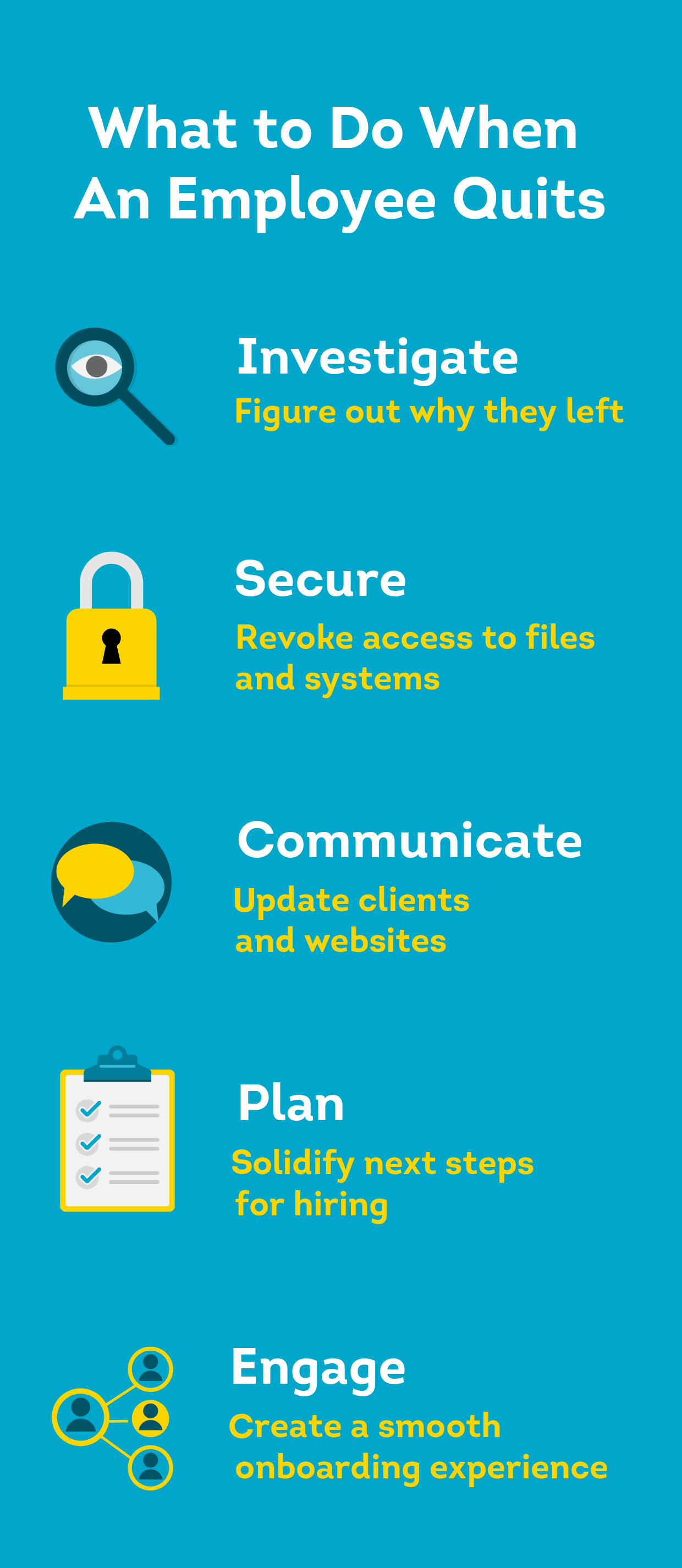An employee who quits can disrupt your company culture and your bottom line. Whenever someone leaves, it’s essential to find out why they left, revoke access to sensitive files and systems, and communicate with your clients. Then, you need to start a new hiring process, while making sure to conduct thorough employee screening to help prevent potential disaster. Read more to find out what to do if an employee quits.
Remember that this material is intended to provide you with helpful information and is not to be relied upon to make decisions, nor is this material intended to be or construed as legal advice. You are encouraged to consult your legal counsel for advice on your specific business operations and responsibilities under applicable law. Trademarks used in this material are the property of their respective owners and no affiliation or endorsement is implied.
Whether in love or business, breaking up is hard to do. However, when it comes to employees who quit, it’s your bottom line that can be shattered instead of your heart.
According to Gallup, turnover can cost companies one-half to two times the departing employee’s salary. For an average U.S. office worker, that could be $20,000 to $100,000 or more a year—which is no happily ever after for small business owners.
In addition to lost productivity and hiring costs, staff members who split can be expensive in unexpected ways. Without strategic post-departure management, small business owners can lose customers and unintentionally create massive security and data vulnerabilities. These can lead to devastating lawsuits and other damaging consequences.
Considering that, according to Gallup, 48% of the workforce actively sought new jobs in 2021, it’s essential for small business owners to know what to do when an employee quits. Then, once it’s time to bring in someone new, it’s crucial to prevent the next disaster with a solid hiring process and thorough high-quality preemployment screening through a reputable service like Shareable for Hires.
This article covers how to mitigate financial loss by figuring out why a departing employee left, how to responsibly manage outgoing employee access and client relationships, and how to successfully bring someone new onboard.
Advanced planning may not completely prevent financial blows, but thoughtful preparation with the advice below could potentially save you from some heartache and anguish.
1. Investigate: Figure Out Why They Left

The loss of an employee can be a massive hit to your small business, both in terms of company culture and your bottom line. That said, every departing employee is also an opportunity to improve your small business.
When someone leaves, conduct a formal exit interview. Ask a series of comprehensive, predetermined questions that give your employee a chance to provide honest feedback.
Here are some examples of questions to ask in an exit interview:
- Why are you leaving this company?
- Could we have done anything differently to encourage you to stay?
- What were the biggest positives and negatives about working here?
- What are your suggestions for improving the work experience?
Be open to the feedback you receive. Even if a departing employee is angry or disgruntled, they can still have valid points that will improve your business. Listen actively, take notes, and seriously consider all changes that could make your small business a better place for your workers.
If the employee left due to poor work culture or other aspects you have control over, consider creating an employment retention strategy.
Why Good Employees Quit—And What You Can do About It
Many small business owners might assume compensation is the main reason workers quit. Although everyone wants a fair wage, money alone is rarely the primary reason employees leave. According to Hays Recruiting, 71% of employees would even take a pay cut for their ideal job,
The Gallup study mentioned above states the major reasons employees wanted to leave their job were: 1) lack of flexibility, 2) burnout, and 3) poor management—all of which led to lack of employee engagement.
Even if you can’t offer higher wages, improving benefits or providing creative small business perks like flex-time, dog-friendly offices, or commuting credits can help you remain competitive.
Additionally, while an exit interview is a crucial responsibility, it should not be the first or only time you speak to staff members about their employment. Help increase engagement by building in times for regular one-on-one check-ins and group meetings on an on-going basis
2. Secure: Revoke Access to Files and Systems

Even if an employee left on good terms, it’s vital to remove their access to all company systems and files as soon as possible. Giving non-employees access to sensitive client data, company property, financial information, or even social media accounts is a major liability issue that can lead to catastrophic consequences if the data reaches the wrong hands.
Outgoing employees may no longer be covered by company confidentiality agreements, NDA’s, professional liability insurance, and more. You could be left on the hook for any damages that arise from improper access—even if an oversight was unintentional.
Examples of access to revoke for employees who quit include:
- Log-in credentials for company computers
- Intranet and digital file access
- Physical computers, tablets, and hardware
- Cloud-based third-party software, such as storage drives, design programs, time-clock apps, communication/messaging channels
- Email lists, blogs, social media accounts
- Parking passes and/or security cards
- Employee ID or credentials with photos
To make the process of revoking employee access easier create a technology and website checklist that includes all systems than an employee can view, along with the person or department that manages each. Having a list ahead of time makes cleanup an organized, simplified process.
To further reduce your liability for improper system access, make sure to run comprehensive background checks—including employee criminal history reports—before any new employees start.
3. Communicate: Update Clients and Website

According to a study undertaken at the Cornell School of Hotel Management, high employee turnover often leads to unhappy customers and deteriorated services. If your employee who quits works one-on-one with clients, it’s imperative to combat the negative effects of turnover with good communication.
For customer facing-employees, try the following:
- Create a plan. If possible, work with your outgoing employee to create a transition plan. Decide who will take over what responsibilities and make sure remaining staff members are ready for this increased workload. If your employee has already left, work with your current staff to divvy up clients.
- Communicate proactively. Don’t make your customers wonder what’s going on. Once you have a plan in place, send an email outlining the new contacts and workflow. This communication should be positive and reassure your clients that the change will not impact the level of service they receive. Additionally, forward voicemails and create an auto-response from the employee’s email address detailing how customers can get assistance.
- Prevent unexpected disruptions in the future. You don’t always know ahead of time if someone is leaving. Include contingency plans for surprise departures in your ongoing structural reviews and make sure to meet with employees regularly to get ahead of potential issues.
In addition to managing current customers with the tips above, instill confidence in potential and new customers. Keep your company directory, website, or structure page updated. Keeping people that no longer work at your company on your website looks unprofessional and disorganized. It can be a turnoff to potential new business partners.
4. Plan: Solidify Next Steps for Hiring

Replacing outgoing employees can cost tens of thousands of dollars (or more) in lost productivity, turnover, and searching for a replacement. When an employee quits, maximize your time with the following tips for a more efficient hiring process:
Step 1: Prepare a Job Description
You might be in a hurry to replace a departing employee, but you shouldn’t rush to create a job description. Learning how to write a good job description can be the difference between attracting hundreds of high-quality applicants and getting no response at all.
When crafting a notice, consider the role within your organization, the exact duties, the compensation, and the required skills and background. Once you have a great write-up, think about where to post it to attract the exact kind of candidates you seek.
Step 2: Review Application Materials
Once the resumes start rolling in, it’s time to review your candidates. As unfortunate as it is to face, not every job applicant has the best intentions at heart. Learn how to review application materials and how to spot resume fraud—especially if it’s been a while since your last search.
Pay special attention to how long people have stayed in past positions to see if there is a history of job-hopping that could harm your business.
Step 3: Remote and In-Person Interviews
After you have a shortlist of promising candidates, it’s time to ask for interviews. Most interviews occur in two stages: an initial online or phone interview, followed by an in-person session for finalists.
Interviewing several candidates can get overwhelming quickly. Consider using interview scorecards and standardized lists of questions to help you stay organized. Using the same criteria for all applicants not only makes objective comparison easier but can also make the process more equitable.
Step 4: Background Checks and Screening
As you seriously consider job finalists, it’s imperative to verify the picture they painted is accurate by learning more about their history. First, contact an applicant’s previous employers (with their consent, of course) and know what questions to ask during a reference check.
When you’re ready to make an offer, make it clear that hiring is contingent on successfully passing a background check. Thorough preemployment screening should include information about an applicant’s past criminal history and, if relevant, a credit check.
When selecting a background check service, make sure they provide legal, FCRA-compliant screening that includes all the information you need.
Additionally, saving time in the hiring process is essential—especially for small businesses. Know how long a background check should take and make sure your provider can deliver a quick turn-around time. If not, you might lose your top candidates to companies who can supply an offer more quickly.
Traditional Background Checks vs. Online Screening
Although often well-established, many traditional background check firms can take weeks to provide results and often offer services at prices and subscription tiers that are inaccessible to small business owners. Signing up with a traditional firm can mean a long application process, lengthy company assessments, sign-on fees, and a whole load of headache.
These days, it’s much easier for small business owners to screen job applicants with an online service like ShareAble for Hires. Instant access with no sign-up process, affordable prices, and lightning fast, on-demand background checks mean you could potentially interview, screen, and offer a great applicant a job on the same day.
5. Engage: Create a Smooth Onboarding Experience

An employee’s resignation can leave your team shaky and disorganized. However, it’s essential not to let that uncertainty seep into your new hire’s experience. According to a JobVite study, over 30% of workers have left a job in the first 90 days of employment. When you bring in someone new, be straightforward and organized—otherwise your new hire might leave.
The top three reasons for leaving a job within the first three months are:
- The job wasn’t as expected
- There was a negative experience early on, or
- The company culture was a poor fit
To help combat early departures, be clear about the position in applicant materials and interviews. Additionally, create an onboarding plan which includes a robust schedule for at least the first few days. Make sure your employee knows how to get questions answered and have a workstation—or other required supplies—already prepared, so that your new hire knows exactly what to do and where.
The above tips lead to higher job engagement early on, which can mean better employee retention and outcomes.

Screen New Employees with ShareAble for Hires
Just like in love, an employee splitting up with your company can bring both heartache and great opportunities to find a new special someone. However, before you fall head over heels for an attractive resume and jaw-dropping references, make sure you know exactly who you’re hiring with comprehensive employee screening through ShareAble for Hires.

Simplify your outgoing-employee procedures with instant background checks that are designed specifically for small business owners with only occasional screening needs. Criminal reports scour dozens of federal agencies and databases for matches, while identity verification helps confirm your applicant is exactly who they say they are. Knowing the details of your job applicant’s history can help you make better hiring decisions.
If your new employee will handle cash or personal client information, a preemployment credit check can give you a better idea of their track record with sensitive data. With reports backed by TransUnion—a major credit agency—you can feel more confident that your potential new employee is who you want to hire.
Simply create a free account to get started. Reports are delivered in minutes and include the details you need to increase your chances of finding Mr. or Mrs. Right.
Not every employee-employer relationship is a match made in heaven. Help find your next big someone with ShareAble for Hires.
ShareAble for Hires
Sign-up Now. Reports Now. Hire Now.







